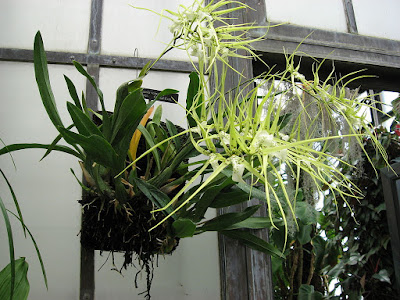Brassia verrucosa orchid was first described by Lindley in 1840. This pants is native to Mexico, Central America (Costa Rica, El Salvador, Guatemala, Honduras, Nicaragua), Venezuela, and Brazil, in open humid, evergreen to semi-deciduous cloud forests, on tree trunks and larger branches at elevations of 900 to 2400 meters.
Brassia verrucosa orchid, also called as The Warty Brassia, is a species of the genus Brassia. Several synonyms are know for this species such as: "Brassia aristata Lindley 1844"; "Brassia brachiata Lindley 1842"; "Brassia coryandra C. Morr. 1848"; "Brassia cowani R.H. Torr. ex Lindl. 1854"; "Brassia longiloba DC 1848"; "Brassia odontoglossoides Klotsch & Karst. 1847"; "Brassia ophioglossoides Klotzsch & Karst."; "Oncidium brachiatum Rchb.f 1864"; "Oncidium verrucosum [Lindley]Rchb.f 1863".
IDENTIFY BRASSIA VERRUCOSA ORCHID
Brassia verrucosa orchid was first described by Lindley in 1840. This pants is native to Mexico, Central America (Costa Rica, El Salvador, Guatemala, Honduras, Nicaragua), Venezuela, and Brazil, in open humid, evergreen to semi-deciduous cloud forests, on tree trunks and larger branches at elevations of 900 to 2400 meters.
This orchid is a large sized, warm to cold growing epiphyte with ovoid-conic, furrowed, slightly laterally compressed pseudobulbs subtended by 1 to 2 foliaceous bracts and has 2, coriaceous, elliptic-lanceolate leaves that are conduplicate at the base. It has upright, flattened, egg-shaped, medium green pseudobulbs about 8cm (3 inch) tall and 7cm (3 inch) wide. Each pseudobulb carries two leaves about 38cm (15 inch) long and 5cm (2 inch) wide.
The plant flower in the late spring through the early autumn on a basal, to more than 2' (60 cm) long, erect to arching inflorescence arising on a mature pseudobulb which are strongly 2 ranked and carry many (10 to 20) flowers. Each flowers grows up to 12-15cm (5-6 inch) long and 10cm (4 inch) across. Some forms, with flowers 20-25cm (8-10 inch) long and 10-12cm (4-5 inch) across, are sometimes thought to be a separate species and are given the name Brassia brachiata. The sepals and petals are pale green spotted with dark green, red or brownish purple, mainly near the base. The roughly diamond-shaped lip is white with dark green, wart like spots. As the flowers open consecutively along the stem over a period of days, by the time the last are opening, the petals and sepals of the early flowers are a deeper color. The younger of the flowers are scented, but again there is a deterioration to an odor as they age. The flowers will stay on the plant for about 3 weeks.
GROW AND CAE BRASSIA VERRUCOSA ORCHID
This species is included in the list in Annex II of the CITES International Convention on Trade in Natural Resources. Just remember that special needs of this plants: bright but filtered light; intermediate to cool temperatures; apply a weak foliar fertilizer fortnightly during active growth; allow three weeks rest after flowering. As follows:
Light, temperature and humidity:
The Warty Brassia needs a bright light exposure, intermediate so that it will not scald in hot direct rays but also not so dim that the foliage turns dark green. Minimum temperature in winter for growing is about 8-10 °C (46.4 - 50 °F), and the ideal is 28-30 °C (82.4 - 86 °F) with 60-80% of air humidity. Higher humidity is recommended in summer or windy, more sun-exposed situations. Ideally this species should be in a warm environment year round to support its constant growth. Also, good air circulation is essential: the air flow should be moist and gentle – no orchids like draughts.
Growing medium and cultivate:
It cannot be grown in soil. Rather, mount the clump upon a cork bark slab or upon a tree trunk or palm in partial shade. If grown in a heavy pot or wooden basket, use medium-sized bark for the roots to grow through.
Watering:
Water it frequently in its fast-draining situation during the active growing season of spring to fall and then slightly less in a very short winter dormancy. These orchids come from areas high humidity for most of the year, so keep them well misted with good ventilation and evenly moist and change the watering practices at any stress signs shown by plants.
After flowering has ceased, encourage these plants to rest for a short time (about three weeks). During this rest period give only enough water to keep the mixture from completely drying out or the pseudobulbs from shriveling. While these orchids enjoy high humidity and moist potting mix, they will not tolerate wet feet. Never allow the root zone to sit in water.
Fertilizer:
A balanced fertilizer will work best for Brassia verrucosa: 1/4 teaspoon 20-20-20 with 4 liters of water for irrigation is good. Feed them a weak weekly liquid fertilizing by following the instructions on the fertilizer package except make the solution at quarter strength. In case of over-fertilizing, flush the pot thoroughly.
Repot:
Move Brassia verrucosa plants into container two sizes larger whenever more room for new pseudobulbs is required – about once every two or three years. The best time for repotting these orchids is in spring. To reduce any root damage, soak the container where is grown the orchids for ten minutes in warm water to make roots more pliable and easier to remove from the pot.
Note:
The colour of the leaves of Brassia verrucosa orchids is a good indicator to the health of the plant: mid green indicates good health, dark green indicates the plant is growing in too little light, which may affect its flowering potential and yellow leaves indicates too much light.















COMMENTS